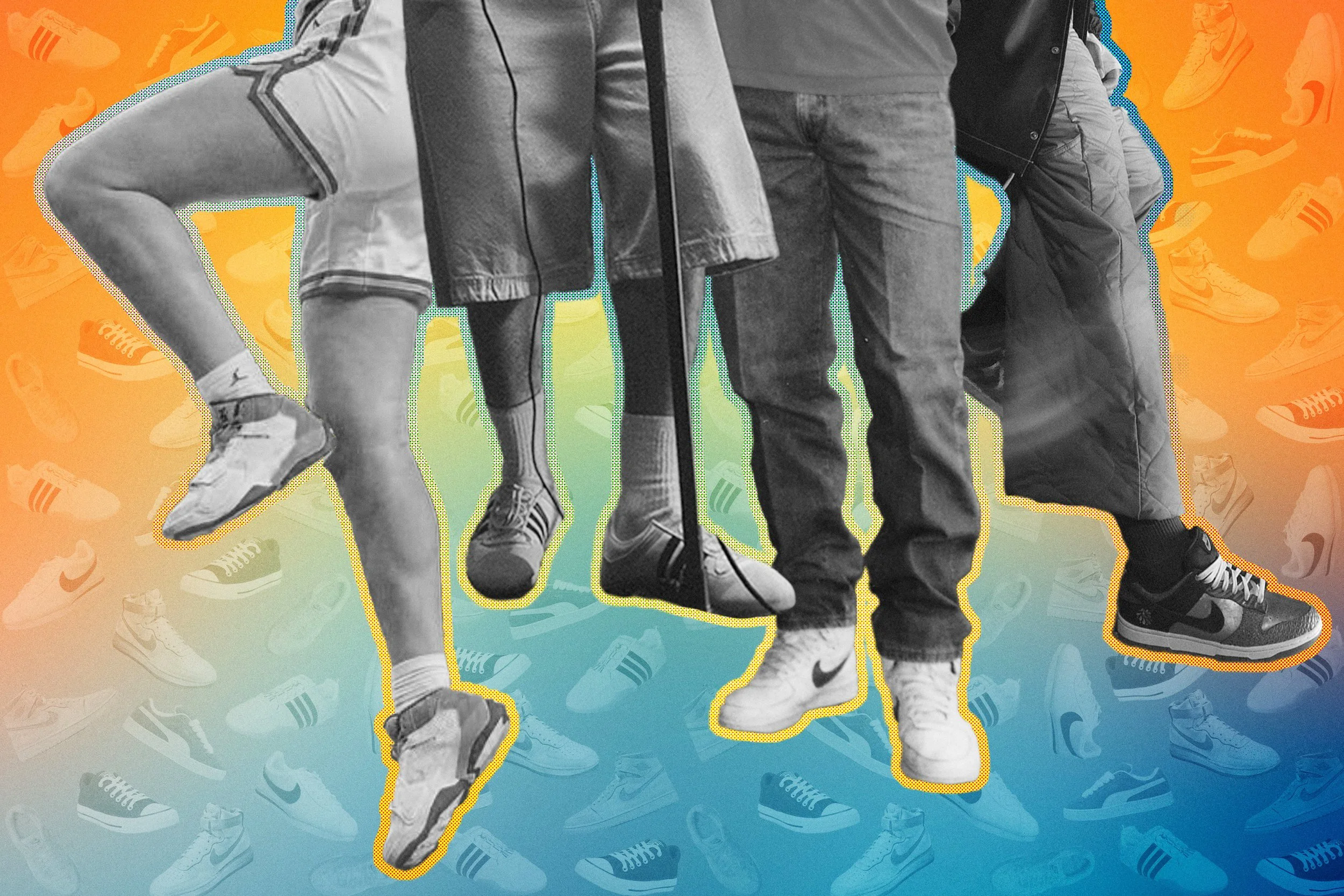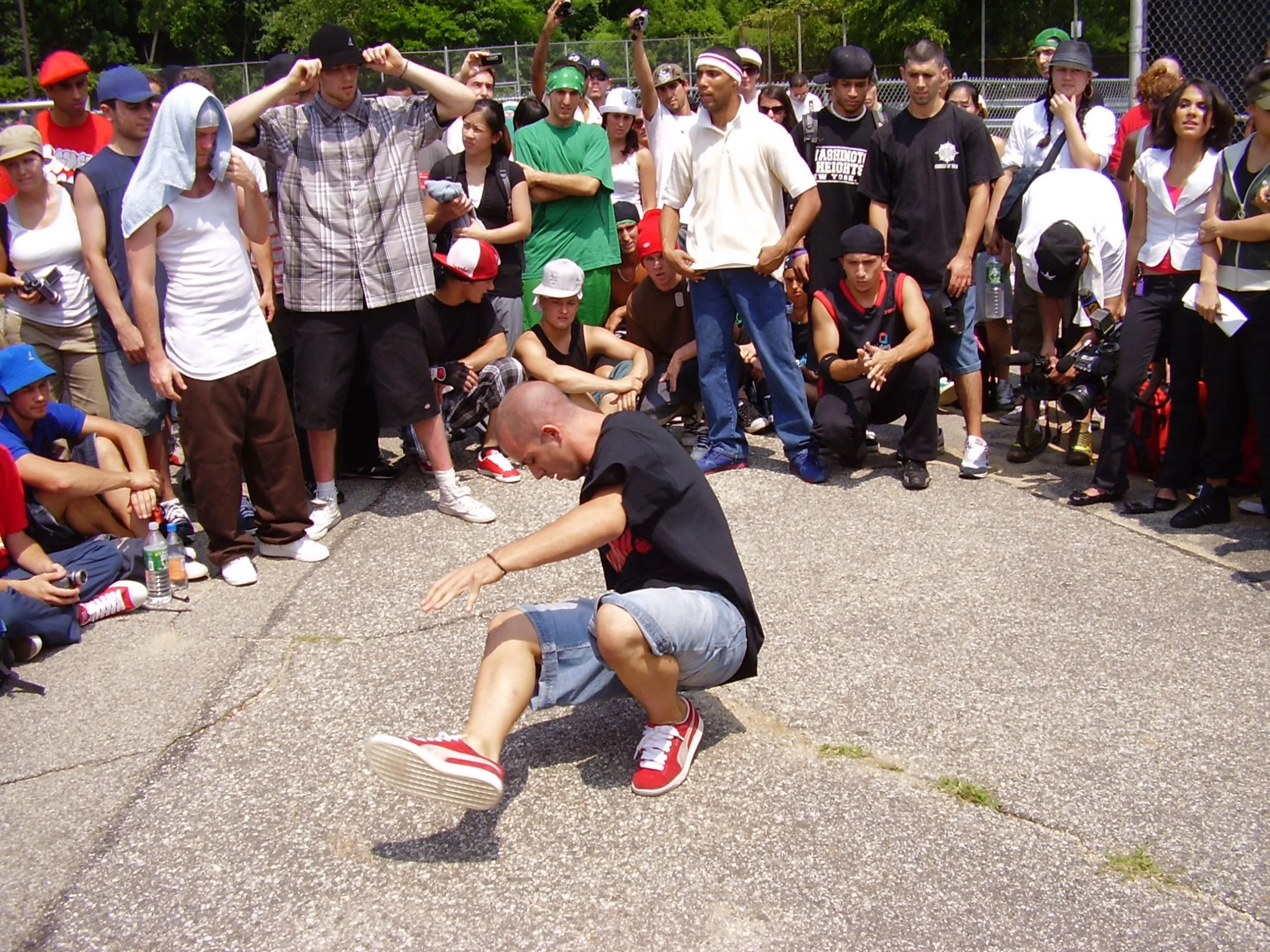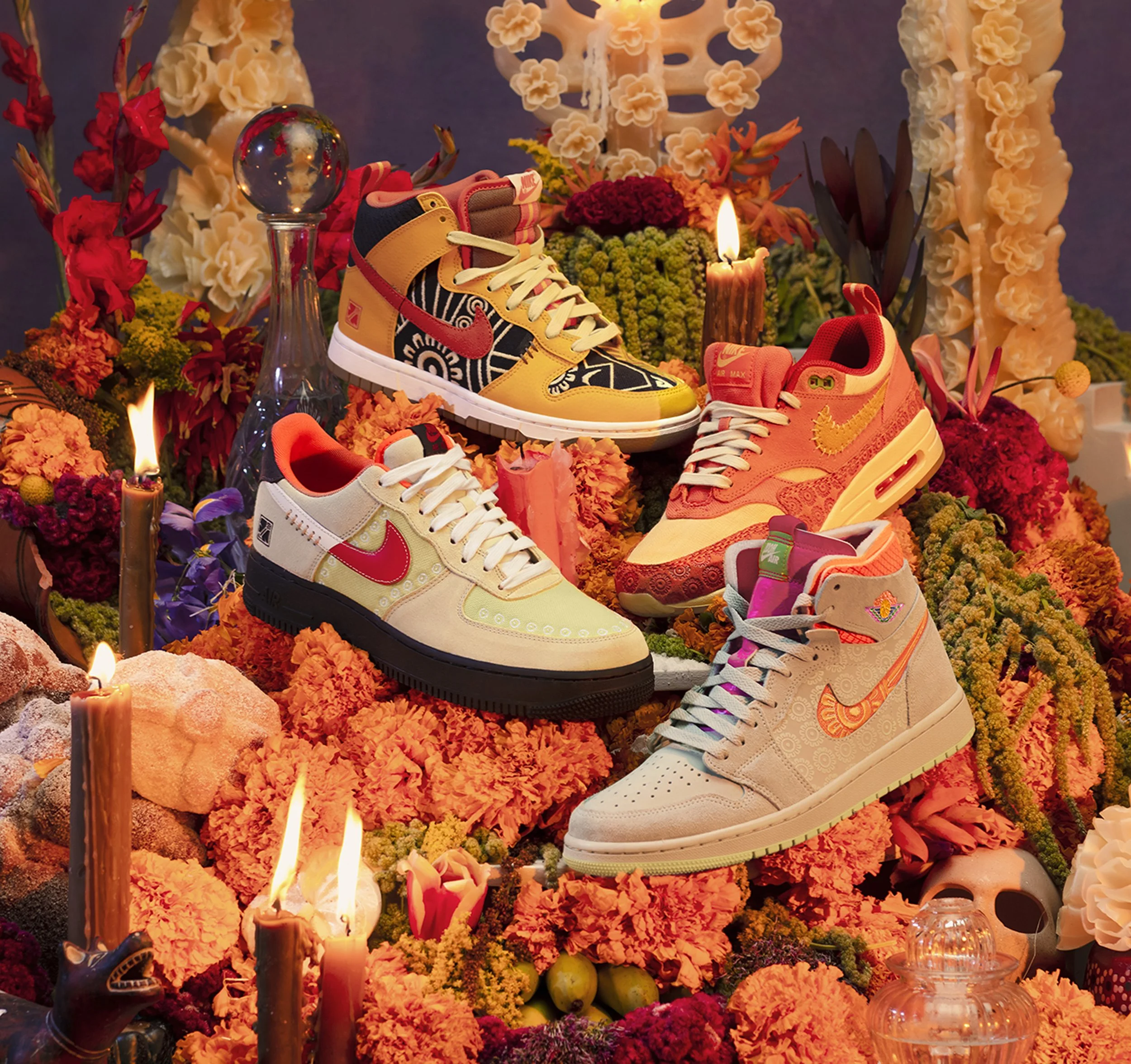Latinos Bring Flair to Sneakerhead Culture
Photo illustration by Yunuen Bonaparte for palabra
More than just kicks, there’s a real cultural legacy of sneakers in the community.
A few days before Mexican American guard Gabriela Jaquez and her UCLA Bruins teammates squared off against the Connecticut Huskies in the women’s Final Four basketball tournament, Nike’s Air Jordan line gifted each player on the team a fresh pair of “White Cement Grey" Air Jordan IV First Flight basketball sneakers.
The retro kicks, scheduled to be released next month, are already in high demand, reportedly fetching offers of a minimum $500 a pair on the vibrant secondary basketball shoe market.
As a key player on one of the best teams in the country, Jaquez, of course, laces up her sneaks to compete on the court for a powerhouse Division 1 team. Millions of other Hispanics who play organized and pickup hoops at all levels – from middle school and high school to youth leagues, college, and the pros – consider performance factors, such as support and traction – when it comes to choosing basketball shoes.
Many Latinos who don’t play hoops at any level love sneakers. In addition to their importance for high-level hoops competitors, basketball kicks have held cultural significance for Latinos for generations. From New York to Miami, Houston to Chicago, Los Angeles, and countless other cities, Latino sneakerhead culture is thriving.
Through the 1960s, basketball shoes were viewed primarily through the prism of function on the court or asphalt. In the early to mid-1970s, sneakerhead culture – the appreciation of hoops kicks because they’re fashionable or make a cultural statement– began to blossom, and Latino consumers were there from the start.
Sneaker culture emerged during that time in New York City, says Elizabeth Semmelhack, director and senior curator at the Bata Shoe Museum in Toronto. “There was this incredible moment where there was an intertwining of basketball, hip-hop, and New York City culture, which of course includes a large Hispanic presence,” Semmelhack says. “The Puma Clydes came out. They were available in beautiful suede colors and named after New York Knicks star Walt ‘Clyde’ Frazier, who was on many best-dressed lists.”
B-boy Pumba wears red Puma Clydes sneakers during a cypher at Rock Steady Crew's 30th anniversary "Concrete Battle" celebration in the Bronx in July 2007. Photo by NexusMoves, via Wikimedia Commons
Many people who had never touched a ball began to embrace sneakers for their fashion and comfort. In New York City, break dancing teams – which included many Latinos of Puerto Rican and Dominican descent – performed their routines in Nikes, Converse, Adidas, Reeboks, Brooks, and Avias.
“You had this commingling born out of the different neighborhoods of New York representing a variety of cultures,” Semmelhack adds.
In addition to curating the museum, Semmelhack wrote “Out of the Box: The Rise of Sneaker Culture,” which features an introduction by New York City-based author Bobbito García. Semmelhack says García coined the term “sneakerhead” to refer to people passionate about sneakers, know their history, and collect and trade basketball shoes.
Bobbito García wearing vintage Nike Air Force 1 sneakers in 1987. Photo by Ramón García, courtesy of Bobbito García
Leaning into Latino sneakerhead culture, some sneaker brands have collaborated with Hispanic celebrities or created specific lines of shoes that lean into Latino culture.
For example, in 2021, Adidas announced the beginning of a creative partnership with Bad Bunny. The shoe brand’s announcement lauded Bad Bunny as a “Grammy-nominated musician, an entrepreneur, a social activist, and a fashion icon whose sense of style transcends boundaries.”
Bad Bunny’s 2021 Adidas Originals collaboration, the Forum Buckle Low “The First Café” sneaker, reworks the classic court silhouette with nods to his coffee ritual. Photo courtesy of Adidas
The first model of the collaboration was the Originals Forum Buckle Low sneaker, named “The First Café.” The kicks – a nod to the cup of coffee Bad Bunny consumes as part of his daily routine – feature a leather upper, a buckle fastening, and an off-white/gray/white colorway.
The Bad Bunny line of sneakers is on the pricey side. For instance, the Bad Bunny Forum Buckle Low Easter Egg model, in pink and dark pink, retailed for $160 when it was released in 2022.
“I have always loved sneakers since I was a kid,” Bad Bunny said in the Adidas announcement. They were the essential detail of the style I wanted and the look I wanted to have depending on what I was going to do that day. I would go out with my friends and we would ask each other, what sneakers are you going to wear today? Today, it feels great to create my own design with people who I share the same sentiment.” The artist is also a big fan of basketball and is a co-owner of the professional basketball team Cangrejeros de Santurce in Puerto Rico.
Bad Bunny wears his Adidas latest collaboration, "Ballerina" off-white sneakers. Photo courtesy of Adidas
The U.S. market for sneakers is huge, generating more than $25 billion in sales annually, according to Statista.
Nike has been aggressive in courting Latino sneakerheads. In 2023, Nike dropped the “Con Mi Familia” (With My Family) collection in celebration of Hispanic Heritage Month. The collection included classics such as the Air Max 1 and the Pegasus 40 in vibrant colors and textures, “a collaboration between Latino designers across the Nike brand including Nico Rodríguez Bagué, Rachel Denti, Angela Sevilla Lugo, Daniela Triana-Mayorga, and Juan Carlos Huerta.”
It wasn’t Nike’s first Latino collaboration. In 2020, J Balvin became the first Latino artist to collaborate with the Jordan Brand. In 2017, during Hispanic Heritage Month, Nike released several sneakers – an Air Jordan 1, Air Max 1, Air Force 1, and Classic Cortez – designed by Pomb, Wasafu, Saner, and INTI, respectively.
Nike’s 2023 "Con Mi Familia" collection celebrates Hispanic Heritage Month with footwear and apparel honoring family traditions. Photo courtesy of Nike
Sneakerhead culture has endured among Latinos and others for a number of reasons, says Sean Williams, co-founder and program lead of SOLEcial Studies CommUNITY Academy, a program in Brooklyn, N.Y., that teaches about the business and culture of sneakers. “Society has dramatically warmed up to accepting sneakers in spaces where they weren't accepted before, such as schools, the workplace, churches and clubs,” Williams tells palabra. “Also, there are way more options for people to get involved as a consumer. There are many more brands internationally that also contribute to the global participation in the sneaker experience.”
Then there is the appeal of cultural figures. “Artists like Bad Bunny have been one of Adidas' best and most successful collaborators in the last few years,” Williams mentions. “Lionel Messi is another example of the Latin influence internationally on sneakers in sportswear apparel. Nike has done great work in the past with LA-based artists like Mr. Cartoon. He has done a great job of making sure the story of Chicano culture is included in those product collaborations.”
García, the author of “Where’d You Get Those?” and a handful of other basketball-themed books, noted that Nike’s Jordan brand created a signature sneaker for former NBA star Carmelo Anthony, who is Afro-Boricua. “In 2010-11, Carlos Arroyo, a star of Puerto Rico’s national team, and JJ Barea, who helped the Dallas Mavericks win the NBA championship that season, were both signed to Converse and helped usher in their Player Evo to market to some success.”
Puerto Rico natives Carlos Arroyo (left) and JJ Barea of Team Converse served as honorary monitors at the inaugural Converse Open Gym Puerto Rico in 2011. They shared how basketball shaped their lives with more than 1,000 participating youth. Photo courtesy of TeamWorks Media/Converse
Producing Latino-leaning basketball shoes sneakers is good business for sneaker brands. Annually, Latinos spend $33.9 billion on shoes and clothing, according to Refuel Agency, which leads a network of specialized marketing groups that provide access to niche markets. Nike and Adidas are among the more popular brands among Latino consumers, says Refuel.
Support the voices of independent journalists.
|
Marketing to Hispanics makes good business sense. Overall, the buying power of Latinos in the U.S. is $3.2 trillion, according to the 2023 LDC U.S. Latino GDP Report, authored by researchers from Arizona State University.
The future could be bright for Latino – and Latina – athletes when it comes to endorsements.
García notes that Nike, for example, recently signed basketball star Isabella “Bella” Hines, who lives with her family in New Mexico, to a Jordan brand NIL deal. She’s committed to playing for LSU.
“She’s still in high school!” García exclaims.
—
Ruben Castañeda is a Washington, D.C.-based journalist with more than three decades of experience as a reporter and an editor. He has worked for the Washington Post and U.S. News & World Report, and is the author of the book, “S Street Rising: Crack, Murder and Redemption in D.C.” @sstreetrising
Patricia Guadalupe, raised in Puerto Rico, is a bilingual multimedia journalist based in Washington, D.C., and is the interim managing editor of palabra. She has been covering the capital for both English- and Spanish-language media outlets since the mid-1990s and previously worked as a reporter in New York City. She’s been an editor at Hispanic Link News Service, a reporter at WTOP Radio (CBS Washington affiliate), a contributing reporter for CBS Radio network, and has written for NBC News.com and Latino Magazine, among others. She is a graduate of Michigan State University and has a Master’s degree from the Graduate School of Political Management at George Washington University. She specializes in business news and politics and cultural issues. She is the former president of the Washington, D.C. chapter of NAHJ and is an adjunct professor at American University in the nation’s capital and the Washington semester program of Florida International University. @PatriciagDC










